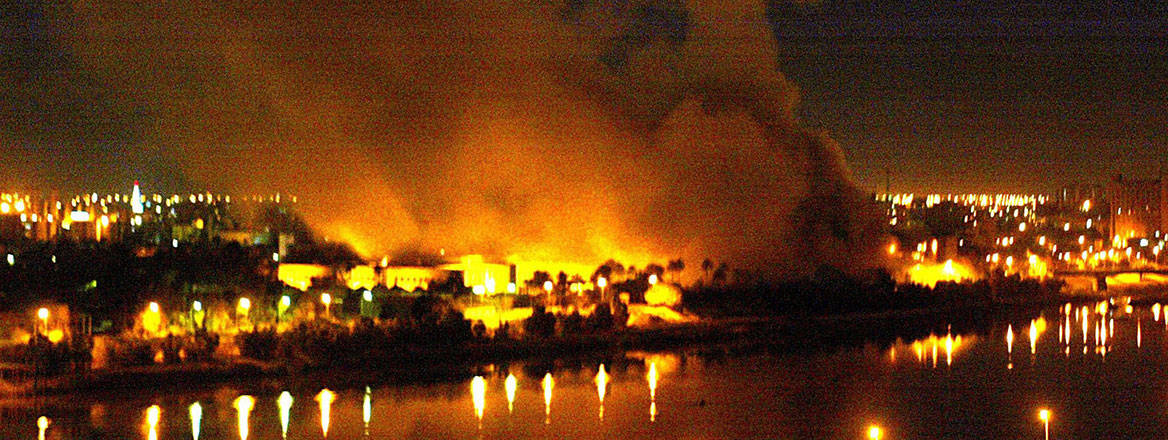The Death of Shock and Awe is Greatly Exaggerated
Far from being a thing of the past, ‘shock and awe’ must be an integral part of our approach to multi-domain warfare in the future.
In March 2003, more than a thousand precision-guided strikes from strategic air assets and stand-off weapons hit Saddam Hussein’s Iraq in the first 24 hours of the US-led invasion. Although the concept of ‘shock and awe’ had entered the military lexicon in the 1990s, it wasn’t truly popularised until the hostilities in 2003 introduced it in a visceral display of kinetic action. The war really did start with a bang. Overwhelming force discombobulated Iraqi decision-makers, fractured their command and control, subdued their armed forces, astonished their populous and, for the first time in history, was watched in real time by the rest of the world.
In simple terms, shock and awe is a colloquialism for a military approach which sets out to overwhelm an adversary through the use of rapid and massive force. It aims to achieve immediate tactical dominance through strikes which cause both a physical and a psychological blow. The adversary is left reeling and unable to respond effectively, while onlookers are surprised and, dare we say it, impressed – even if in a dark, macabre way. The Nazi blitzkrieg was as much a form of shock and awe as the start of Operation Iraqi Freedom.
When taking the long view, it becomes clear that shock and awe has always been part of military strategy and can be found, between the lines, in the principles of war – it is there in Surprise, Offensive Action and in the Concentration of Force. But it is also more than unexpected strike. It happens at the theatre and the political levels, and its impact interrupts decision-making. It is somewhat surprising, then, that in their August 2024 Foreign Affairs article, former Chairman of the US Joint Chiefs of Staff General Mark Milley and former Google CEO Eric Schmidt argued that ‘US military planners are right to have concluded that the era of “shock and awe” campaigns – in which Washington could decimate its adversaries with overwhelming firepower – is finished’.
The thrust of Milley and Schmidt’s article was not specifically about shock and awe, but that the US is not fully prepared for future warfare, which they see as being driven by advanced technologies such as AI and autonomous systems. They emphasise that recent conflicts, particularly in Ukraine, demonstrate how warfare is evolving rapidly. They assert that the battlefield is becoming more transparent, and they predict that future wars will be dominated by new technologies rather than traditional, industrial age forces. We must ‘change or perish’, they opine.
Shock and awe tactics involving massive bombardment may have an initial psychological impact, but the resultant unrest can lead to domestic and international backlash, instability and insurgency
They may be correct, but does this directly render shock and awe dead? Are they thinking too much from a US vantage point and projecting their opinions through the prism of their ‘pacing threat’, China?
We might instead choose to propose that since the character of war continually evolves, then so too does shock and awe. The psychological and operational impact of Israel’s recent ‘Trojan’ attack on Hezbollah in Lebanon, for example, by rigging communications pagers with explosives and covertly delivering them into the hands and pockets of Hezbollah’s leaders, is just the latest iteration of this age-old strategy. The spread of fear, paranoia and distrust of equipment almost certainly did as much damage to Hezbollah’s fighting effectiveness as Israel’s targeted assassinations through more traditional means. And it hit the world news, too. There was shock at the tactic, and there was awe at its audacity.
So, before consigning shock and awe to the graveyard of military ideas, it is perhaps worth unpacking what it actually is, and considering how it might adapt, evolve and be used in the future.
The declared purpose of shock and awe is to inflict rapid, decisive blows, leaving the enemy unable to react effectively or to mount a counteroffensive. The concept was first outlined by former US Navy officer Harlan Ullman and military author James Wade, who argued that the basis for rapid dominance rests in the ability to affect the will, perception and understanding of the adversary through imposing sufficient ‘shock’ and ‘awe’ to achieve the necessary political, strategic and operational goals. The authors believed that by using overwhelming firepower, superior technology and speed, an attacking force could destroy not only the enemy's physical capabilities but also their will to resist.
The effectiveness of shock and awe depends on several factors, including the nature of the conflict, the opponent, and the broader political and social context. Although the strategy can be effective in achieving initial military objectives where the goal is to quickly degrade a state’s infrastructure or neutralise key military targets, as it was in Iraq in 2003, its long-term success and its effectiveness against non-state actors are less certain. For instance, the use of shock and awe tactics involving massive bombardment may certainly have an initial psychologically demoralising and disorienting impact, but the resultant social and political unrest can lead to domestic and international backlash, instability and insurgency. Non-state groups tend to be decentralised and have less infrastructure to target. Even in Iraq, while the initial invasion against the state was successful, non-state insurgencies continued for years. The potential strategic consequences of a tactical action must always be factored into planning.
Modern military operations, including peer and hybrid conflict, increasingly rely on more targeted and precise kinetic and non-kinetic strikes to minimise collateral damage, shifting away from the broad use of overwhelming force. Where mass has been used as the principal advantage, as in Russia’s illegal invasion of Ukraine, it can become bogged down by spirited and innovative resistance. This perhaps reflects an evolution from the ‘traditional’ shock and awe which Milley and Schmidt dismiss as passé, toward strategies that are more focused and adaptable, especially in urban or politically sensitive environments.
However, in conflicts where cyber, economic and information effects are brought to bear alongside traditional military operations, shock and awe may still be relevant, or perhaps even more so. Cyber shock and awe could apply the principles of the traditional version to the digital domain. The goal here could be to achieve overwhelming dominance over an adversary’s digital infrastructure and capabilities, paralysing their ability to respond by launching rapid, large-scale cyber attacks.
A cyber shock and awe campaign targeting critical systems could disable power grids, water supplies and transport networks. It could shut down internet access and disrupt communications. Banks, stock markets and even retail payment systems could be hit, leading to financial and economic chaos. Like the traditional version, cyber shock and awe would create psychological panic. Consider the individual and societal impact if an attacker successfully cut off all communications, power and access to money or means of exchange. Rather than watch events unfolding in real time, digital darkness could be catastrophic as people struggle to make sense of what is happening around them. And, of course, without proper defences, military command and control systems could be crippled. Events such as the recent CrowdStrike outage show us a microcosm of the societal-level mayhem that could be inflicted. Combine this with more traditional effects, and serious damage could be inflicted on to the will of an opponent.
In conflicts where cyber, economic and information effects are brought to bear alongside traditional military operations, shock and awe may still be relevant, or perhaps even more so
We argue that far from being a thing of the past, shock and awe must be an integral part of our approach to multi-domain warfare. We must retain the concept of rapid dominance in our thinking, from contingency planning through to force development. Our offensive thinking must be able to seamlessly synchronise kinetic and non-kinetic kill chains. We must look for mass of effect, not just mass of capability, and we must always aim for the element of surprise.
Similarly, our defensive thinking must evolve and focus more on resilience, redundancy and reversionary modes, and less on ‘efficiency’. We must retain the ability to both survive and thrive in the face of a brutal and unexpected onslaught. Our infrastructure, civilian and military, must be hardened but adaptive. It should be as decentralised and multi-pathed as possible. Our military systems must be ‘network-optional’ by design. Critically, we must consider the physical and psychological impacts of what we do – on the adversary, on ourselves and on onlookers. In the cognitive domain, societal resilience may be every bit as important as military resilience. Day-zero shock and awe thinking can add value to both our offensive and defensive calculus. This is especially true in an age of multiple nuclear-armed opponents when proactive escalation management is required to avoid Armageddon – which may be difficult if the lights go out and communications are down.
It is clear that the right mix of perfectly timed and targeted effects could, more than ever, paralyse an adversary. Conversely, we must appreciate, harden and defend our own potential critical weaknesses, right through to the societal level. We must have a bounce-back strategy because some element of the digital bomber will always get through. We must prepare to deliver shock and be resilient to awe. In both its offensive and defensive contexts, the death of shock and awe has surely been greatly exaggerated.
The views expressed in this Commentary are the authors’, and do not represent those of RUSI or any other institution.
Have an idea for a Commentary you’d like to write for us? Send a short pitch to commentaries@rusi.org and we’ll get back to you if it fits into our research interests. Full guidelines for contributors can be found here.
WRITTEN BY
Joe Dransfield
Professor Kevin Rowlands
RUSI Journal Editor
Publications
- Jim McLeanMedia Relations Manager+44 (0)7917 373 069JimMc@rusi.org




